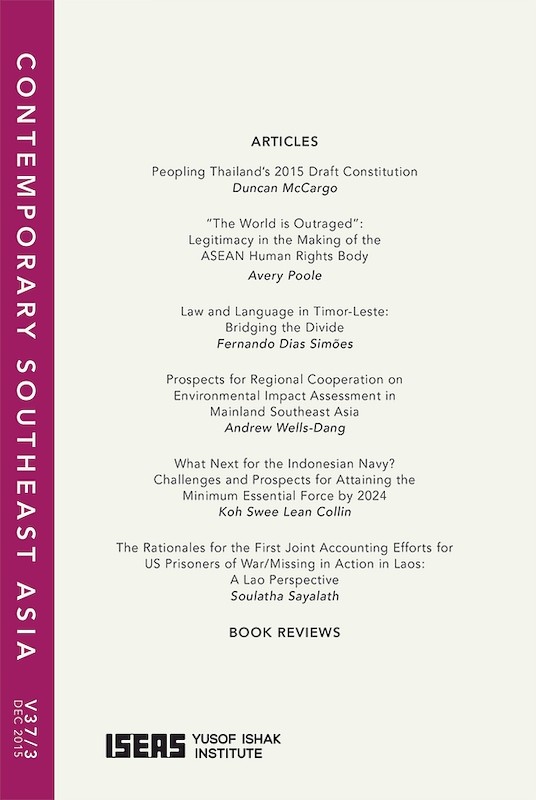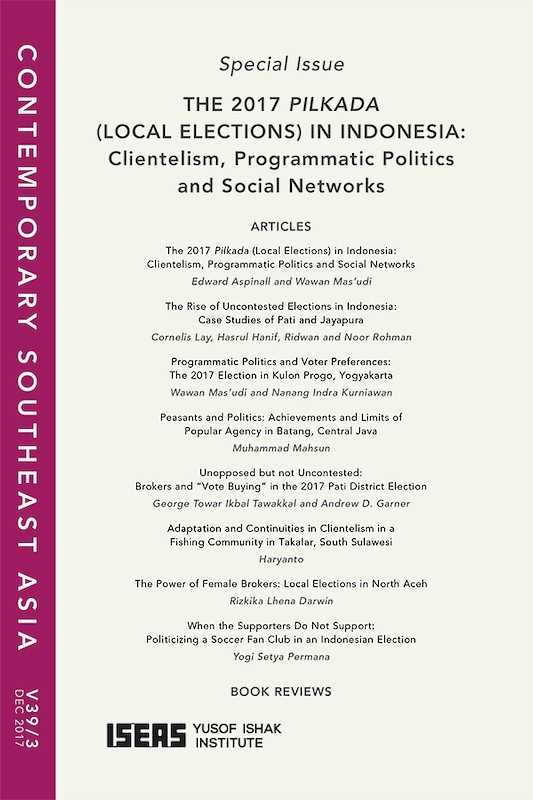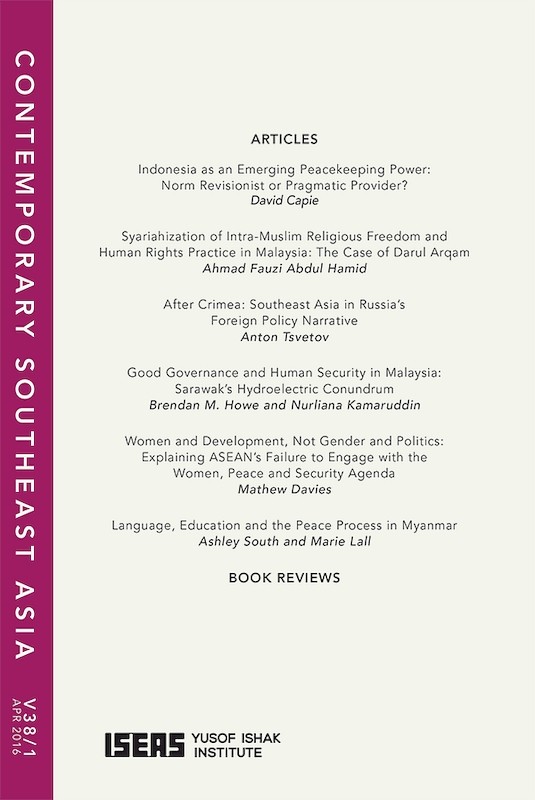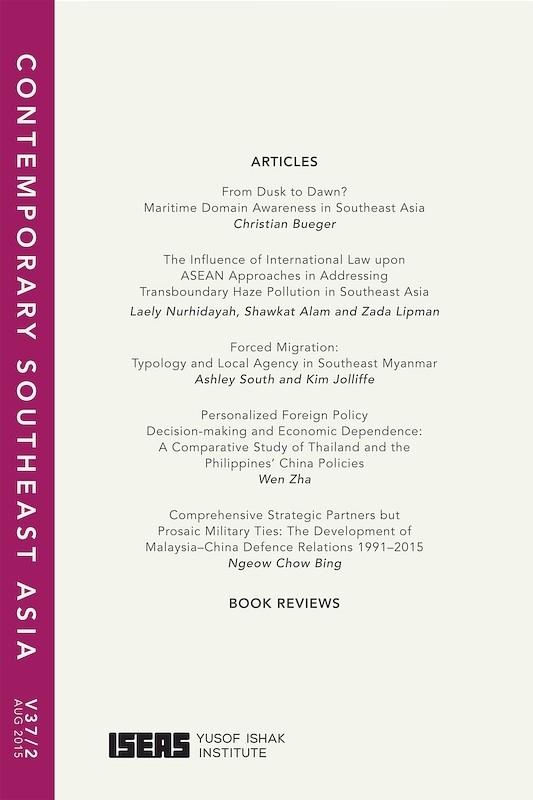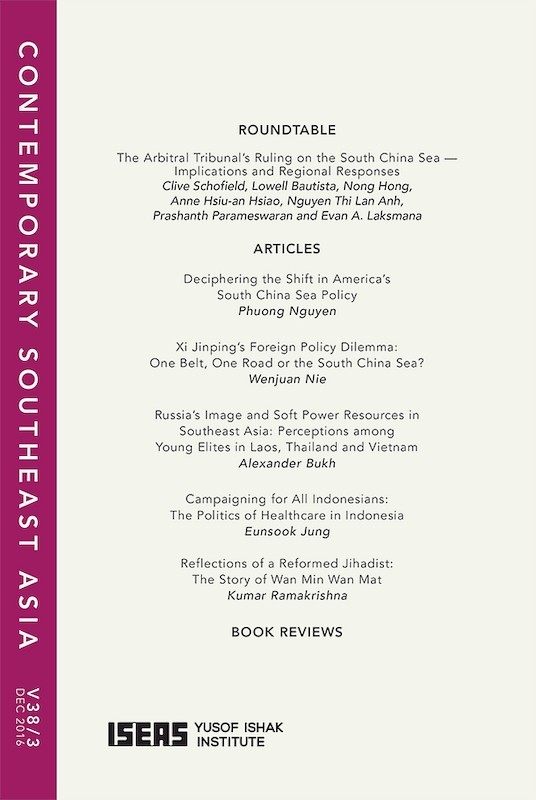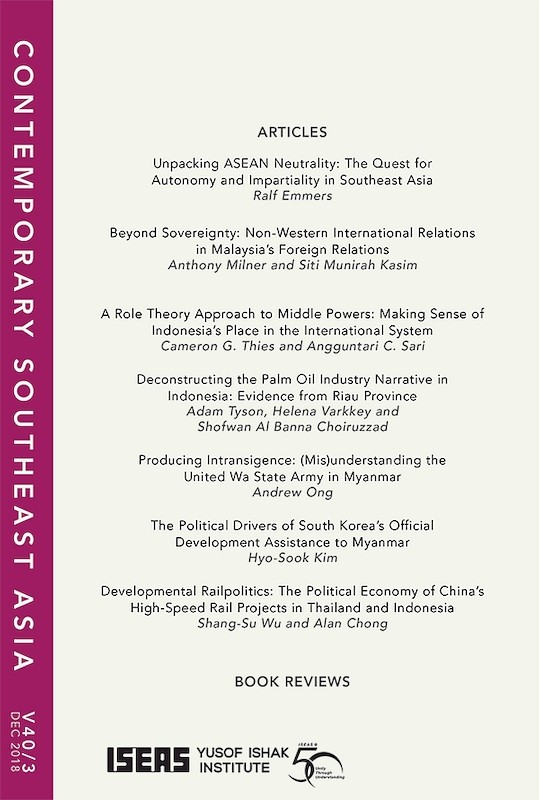Contemporary Southeast Asia Vol. 39/1 (April 2017)
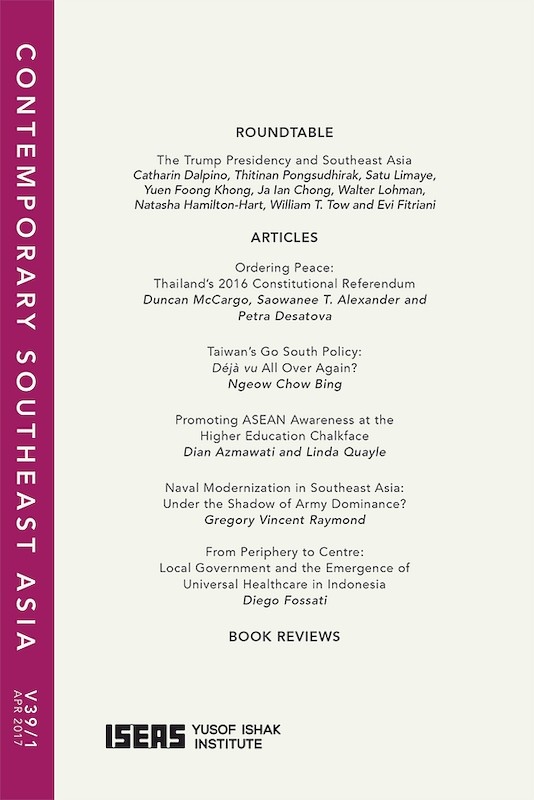
Ian Storey, editor
Date of publication:
April 2017
Publisher:
ISEAS – Yusof Ishak Institute
Number of pages:
228
Code:
CS39/1
About the publication
- Attained impact factor of 0.906 in Social Sciences Citation Index 2017
- Ranked 18th by Google Scholar Metrics 2018 in the Asian Studies and History category
Contents
-
Contemporary Southeast Asia Vol. 39/1 (April 2017)
[Whole Publication, ISSN: 1793284X] -
Preliminary pages
- ROUNDTABLE
-
1. Roundtable: The Trump Presidency and Southeast Asia, by Catharin Dalpino, Thitinan Pongsudhirak, Satu Limaye, Yuen Foong Khong, Chong Ja Ian, Walter Lohman, Natasha Hamilton-Hart, William Tow, Evi Fitriani, authors
- ARTICLES
-
2. Ordering Peace: Thailand's 2016 Constitutional Referendum, by Duncan McCargo, Saowanee T Alexander, Petra Desatova, authors see abstractThailand's August 2016 constitutional referendum marked the second occasion on which a military junta has sought popular endorsement to legitimize its efforts to reform the country's political system. As in the previous referendum of August 2007, Thai voters endorsed military plans to reduce levels of democracy. Draconian moves by the regime curtailed open debate about the content of the draft constitution, which virtually nobody had read. Partly as a result of the junta's suppression of dissent, "No" votes declined — but the draft charter was still opposed by almost 40 per cent of voters, testifying to continuing high levels of political polarization along regional lines. This article argues that the referendum process may have helped the military to impose order on Thai society during the difficult period of royal transition, but did not create any genuine peace between the countrys fractious competing groups and interests.
-
3. Taiwan's Go South Policy: Déjà vu All Over Again?, by Ngeow Chow Bing, author see abstractThe foreign policy of Taiwanese President Tsai Ing-wen, who was elected in 2016, will be closely watched by Beijing and countries in Southeast Asia. Before her inauguration, Tsai stated that her administration would pursue a so-called "New Go South Policy" (xin nanxiang zhengce), i.e. a foreign policy focused on building up ties with countries in Southeast Asia as well as in South Asia. A similar policy was initiated by two former presidents of Taiwan, Lee Teng-hui and Chen Shui-bian. This article provides a framework to analyze the determinants, objectives, policy dimensions and scope of President Tsai's New Go South Policy. It examines and compares the Go South Policies of previous administrations, together with former President Ma Ying-jeou's policy towards Southeast Asia. Based on these discussions, a prospective policy analysis of President Tsai's Go South Policy is provided. It is argued that Tsai's Go South Policy will help enhance Taiwan's soft power, increase the island's presence in Southeast Asia but will not be used to counterbalance China–Taiwan economic integration.
-
4. Promoting ASEAN Awareness at the Higher Education Chalkface, by Dian Azmawati, Linda Quayle, authors see abstractThis research note outlines a project-in-progress, in the hope of soliciting broader participation and discussion. It describes and evaluates a joint initiative between two regional universities to promote inter-class contact and active learning on the subject of the Association of Southeast Asian Nations (ASEAN), and supplements the experience gained in this endeavour through interviews with practising lecturers. Based on these twin research thrusts, the note argues that the higher education chalkface is a vital arena for ASEAN community-building, and pleads for a more concerted effort to link politics and pedagogy. To this end, recommendations include: cooperating to generalize and extend the kinds of small-scale projects discussed in this article; establishing an inclusive, interactive, teaching-oriented website where ideas and material can be shared; setting up a platform where the results of student-driven research and initiatives can be made available; and organizing practitioner-oriented workshops where lecturers can access the combined expertise of ASEAN officials, national diplomats and pedagogical specialists to construct practical, active, and cooperative teaching programmes. If we are to fulfil the tasks of promoting ASEAN awareness, nurturing regional identity, and encouraging public ownership of the regional project among this highly significant sector of Southeast Asias population, then facilitating the task of teaching ASEAN is an indispensable component.
-
5. Naval Modernization in Southeast Asia: Under the Shadow of Army Dominance?, by Gregory V Raymond, author see abstractUsing a historical institutionalist approach, this article addresses the future of Southeast Asia's naval forces. Much analysis on this subject employs a linear Realist model in which Southeast Asia's navies are expected to be the beneficiaries of declining internal security challenges and a deteriorating external threat environment. However, to date neither of these factors, including increasing Chinese assertiveness in the maritime domain, appear to have significantly accelerated naval force development in Southeast Asia. While there have been some capability increases in areas such as submarines, growth has mainly been in patrol boat and fast attack craft classes. Numbers of larger offshore surface combatants like frigates have fallen. This article argues that in countries where army dominance has become institutionalized, and civil control of the military is weak, governments may be unwilling or unable to reallocate funding away from armies to maritime forces. In a funding environment in which national economic growth is moderate, and spending on defence is a lower priority, naval modernization and expansion can be blocked. This article examines the cases of Thailand, Indonesia and Myanmar to demonstrate how their armies became dominant and how this may have diminished the growth prospects of their navies.
-
6. From Periphery to Centre: Local Government and the Emergence of Universal Healthcare in Indonesia, by Diego Fossati, author see abstractWhile the debate on universal healthcare coverage (UHC) often focuses on policy prescription and technical issues, the expansion of access to healthcare in developing countries is an eminently political process. This article analyzes the historical background of the adoption of UHC in Indonesia to articulate two intertwined arguments. First, in decentralized young democracies such as Indonesia, local government can play an important role in health policy by experimenting with innovative health insurance schemes. Although such activism may widen subnational inequalities, it can also contribute to the adoption of UHC by increasing the salience of health reform and by allowing policy learning. Second, institutional developments such as decentralization and the introduction of local direct elections can have a substantial impact on incentives for political elites to provide broad-based social services. This article discusses the relevance of these findings for the comparative literature on UHC and social policy in low and middle-income countries.
- BOOK REVIEWS
-
BOOK REVIEW: War and Peace in the Borderlands of Myanmar: The Kachin Ceasefire, 1994-2011. Edited by Mandy Sadan, by Ashley South, author
-
BOOK REVIEW: Political Dynamics of Grassroots Democracy in Vietnam. By Hai Hong Nguyen, by Andrew Wells-Dang, author
-
BOOK REVIEW: Politics and Constitutions in Southeast Asia. Edited by Marco Bunte and Bjorn Dressel, by Hao Duy Phan, author
-
BOOk REVIEW: Cambodia Votes. By Michael Sullivan, by Sebastian Strangio, author
-
BOOK REVIEW: Religious Violence and Conciliation in Indonesia: Christians and Muslims in the Moluccas. By Sumanto Al Qurtuby, by Chris Wilson, author
-
BOOK REVIEW: Activist Archives: Youth Culture and the Political Past in Indonesia. By Doreen Lee, by Yatun Sastramidjaja, author
-
BOOK REVIEW: Restless Continent: Wealth, Rivalry and Asia's New Geopolitics. By Michael Wesley, by Malcolm Cook, author
-
BOOK REVIEW: Reinventing Indonesia. By Ginandjar Kartasasmita and Joseph J. Stern, by Iis Gindarsah, author

